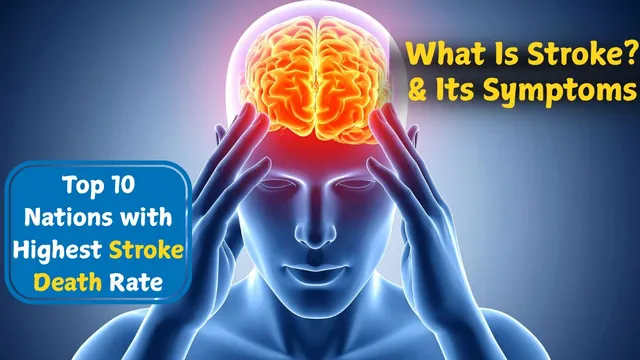- By Aditi Priya Singh
- Wed, 29 Oct 2025 02:36 PM (IST)
- Source:JND
Stroke and Its Symptoms: Stroke, which is one of those diseases claiming several lives every year, is shifting the focus of the international health community. Stroke is the second leading cause of death and a major cause of disability globally. Every year, World Stroke Day is celebrated on October 29, 2025. According to the World Stroke Organisation (WSO) and other reliable sources, nearly 12 million people suffer their first stroke annually, and one in four adults over 25 is expected to have one at some point in their lives. Over 100 million people worldwide are living with stroke, including survivors who frequently experience life-changing issues like physical mobility, paralysis, speech problems, emotions and thought processes and more.
Unfortunately, low- and middle-income countries contribute to about 80% of stroke deaths. While the final ranking of the top 10 nations is subject to change, the high-risk areas are those with poor access to healthcare and high rates of risk factors like uncontrolled hypertension and air pollution.
The urgent need for increased awareness, preventative measures and quick emergency response—where every minute counts to save lives and preserve brain function is highlighted by this serious disease. The message is clear: combating this devastating "brain attack" and its symptoms requires knowledge of them, not just a choice.
What is a Stroke and its Symptoms?
A stroke, sometimes also known as a "brain attack," happens when the blood flow to some parts of the brain is either cut off or severely decreased, depriving the brain tissue of vital nutrients and oxygen, which results in the death of brain cells in just a matter of minutes.
Key Symptoms of Stroke (Remember the F.A.S.T. Acronym):
1. F - Face Drooping: One side of the face might feel numb or droop. Request a smile from the person; is it uneven?
2. A - Arm Weakness: One arm might be numb or weak. Ask the person to raise both of his/her arms; does one drop downward?
3. S - Speech Difficulty: Speech may be slurred, strange or difficult to understand.
4. T - Time to call Emergency Services: Call for assistance right away if any of these symptoms show up—time lost is brain lost.
ALSO READ: Delhi: Air Pollution Now A Major Cause Of Brain Strokes, Lancet Report Finds
Other Sudden Symptoms
*Sudden weakness or numbness in the leg, particularly on one side of the body.
*Unexpected confusion, difficulty interacting or problems in understanding others.
*Abrupt vision problems in one or both eyes.
* Sudden difficulty walking, lightheadedness, or loss of coordination or balance.
* Unknown cause of sudden, intense headache.
| No. | Country | Stroke Death Rate (per 100,000) |
|---|---|---|
| 1 | Kiribati | 233.58 |
| 2 | Mongolia | 216.30 |
| 3 | Lesotho | 211.66 |
| 4 | Solomon Islands | 207.65 |
| 5 | Mozambique | 199.97 |
| 6 | Vanuatu | 190.53 |
| 7 | Myanmar | 185.28 |
| 8 | Montenegro | 184.75 |
| 9 | Central Africa | 181.27 |
| 10 | Micronesia | 181.04 |
Tips for a Stroke-Preventing Lifestyle
By controlling the underlying medical conditions that harm blood vessels (high blood pressure, diabetes, and high cholesterol), these modifications can prevent up to 80% of strokes.
Dietary Adjustments:
Make eating a diet high in fruits, vegetables, whole grains, and lean proteins—such as the DASH or Mediterranean diets—a priority.
To help regulate blood pressure, severely restrict consumption of processed foods, added sugars, saturated fats, and sodium (salt).
Physical Activity:
Try for 150 minutes or more of moderate-intensity aerobic activity each week, such as brisk walking.
At least two days a week should be dedicated to muscle-strengthening exercises (weightlifting, resistance training).
ALSO READ: Are You Ignoring These Silent Signs Of A Stroke, Heart Attack Or Sepsis? Know From Doctor
Quit Tobacco and Limit Alcohol:
Smoking seriously damages blood vessels, so quit and stay away from all tobacco products.
Limit your alcohol intake to moderation, which is one drink for women and two for men per day.
Health Monitoring & Management:
Check and manage your blood sugar (glucose), cholesterol, and blood pressure (the main risk factor for stroke) regularly.
Manage pre-existing conditions such as diabetes and atrial fibrillation (an irregular heartbeat) in collaboration with your healthcare provider.
Weight and Stress:
To lessen the burden on your cardiovascular system, maintain a healthy weight.
Use stress-reduction strategies (such as meditation and getting enough sleep) to help control your blood pressure.

